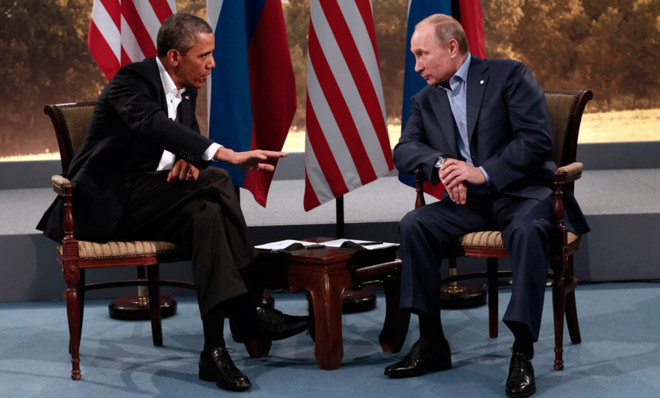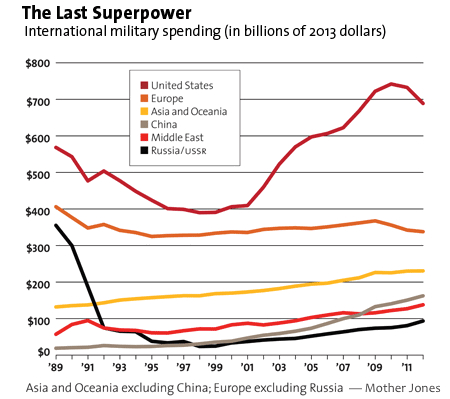What would a U.S.-Russia war look like?
War games are fun until somebody gets hurt


The chances that the U.S. and Russia will clash militarily over Moscow's invasion of Ukraine are very, very slim. Ukraine isn't a member of NATO, and President Obama isn't likely to volunteer for another war. But many of Ukraine's neighbors are NATO members, including Poland, Romania, Slovakia, and Hungary. And so are the the Baltic states — Lithuania, Latvia, and Estonia — further north and right on Russia's border.
If any of those countries come to Ukraine's aid and find themselves in a war with Russia, NATO is obliged to intervene. That's also true if Russia comes up with some pretext to invade any of those countries, unlikely as that seems. If we learned anything from World War I, it's that huge, bloody conflicts can start with tiny skirmishes, especially in Eastern Europe.
Again, the U.S. and Russia almost certainly won't come to blows over Ukraine. But what if they did?
The Week
Escape your echo chamber. Get the facts behind the news, plus analysis from multiple perspectives.

Sign up for The Week's Free Newsletters
From our morning news briefing to a weekly Good News Newsletter, get the best of The Week delivered directly to your inbox.
From our morning news briefing to a weekly Good News Newsletter, get the best of The Week delivered directly to your inbox.

The U.S. is much wealthier than Russia and spends a lot more on its military. That doesn't mean a war would be easy for the U.S. to win, though, or even guarantee a victory: As Napoleon and Hitler learned the hard way, Russia will sacrifice a lot to win its wars, especially on its home turf.
So, what would a war between the U.S. and Russia look like? Here are a few scenarios, from awful to merely bad:
Nuclear Armageddon
Even with the slow mutual nuclear disarmament since the end of the Cold War, the U.S. and Russia each have thousands of nuclear warheads at the ready. As Eugene Chow noted earlier this year, the entire stockpile of U.S. intercontinental ballistic missiles (ICBMs) — 448 active — is essentially aimed squarely at Russia. Russia's hundreds of ICBMs are probably returning the favor.
A free daily email with the biggest news stories of the day – and the best features from TheWeek.com
In all, the U.S. has about 7,700 nuclear warheads, including 1,950 warheads ready to deploy via ICBM, submarine, and airplane, plus thousands more in mothballs or waiting to be dismantled, according to the latest tally by the Federation of American Scientists. Russia has slightly more warheads overall — about 8,500 — but a slightly fewer 1,800 of them operational. China, in comparison, has about 250 nuclear warheads, a bit less that France (300) and a bit more than Britain (225).
Nuclear war with Russia is still mutually assured destruction. Hopefully, that's still deterrent enough.
A conventional war in Eastern Europe
This is the other scenario that never happened in the Cold War. Now, the possibility of scenario one (nuclear Armageddon) makes this one almost equally unlikely. But for the sake of argument, let's assume this hypothetical U.S.-Russia war breaks out in Ukraine, and that other NATO forces are supplementing U.S. troops, ships, and aircraft. Unlike in the Asia-Pacific, where the U.S. keeps China in check (and vice versa, as Eugene Chow explained), NATO provides the United States with a robust military alliance set up specifically to take on Soviet Russia.
The first dynamic is that Russia would have home field advantage: The Russian navy has long called Crimea its home, and whatever troops Russia doesn't already have in Ukraine are right next door, one border-crossing away. The other big starting point is that the U.S. and its NATO allies have Russia effectively surrounded. By its own public count, the U.S. has 598 military facilities in 40 countries, along with the 4,461 bases in the U.S. and U.S. territories.
Along with its large number of bases in Germany, the U.S. has major military installations in Qatar and the Diego Garcia atoll to Russia's south and Japan and South Korea to its east. NATO allies France and Britain are even closer, as this map from Britain's The Telegraph shows:

On top of that, NATO has bases around Russia's western perimeter and in Turkey, right across the Black Sea from Ukraine. What about Russia? "They have a presence in Cuba," more a way station than a base, NYU professor Mark Galeotti tells The Washington Post. And Russia has a naval base in Tartus, Syria. But otherwise "they have no bases outside the former Soviet Union."
Russia has an estimated 845,000 active-duty troops, with as many as 2.5 million more in reserve. NYU's Galeotti isn't very impressed. Russia's military is "moderately competent," he tells The Washington Post. "It's not at the level of the American or British or German military, but it's better than in the 1990s." The Russian troops, especially the Spetsnaz special forces, are "good at bullying small neighbors, but it would not be effective against NATO. It would not be able to defeat China." Galeotti is even more brutal about Russia's Crimea-based Black Sea Fleet:
As a war-fighting force, it's not particularly impressive. Its main vessel was basically built to fight other ships and so is only useful in fighting a naval war. It's got the Moskva, an aging guided-missile cruiser; a large anti-submarine warfare cruiser — very dated; a destroyer and two frigates, which are more versatile; landing ships; and a diesel attack submarine. It's not a particularly powerful force. The Italian navy alone could easily destroy it. [Washington Post]
The U.S. military's 1.4 million active duty troops and 850,000 reservists, but it can't just throw all of them at Russia — somebody has to maintain those 598 bases around the world, as well as defend the U.S.
NATO's Response Force (NRF), which would probably be the first armed unit to engage the Russians, has 13,000 troops at the ready and thousands more in reserve. Here's NATO describing its first-response team, right before NRF war games last fall:

If Russia would have the advantage at sea — Sevastopol is its home port, and the U.S./NATO would have to dislodge its navy — the U.S. would have an edge in the skies, mostly. "The U.S. planes have better radar, missiles, and electronic warfare equipment, while the Russian planes are judged to have superior handling and thrust-to-weight ratio, which would give them an edge in a classic dogfight," says Charles Clover at the Financial Times.
But classic dogfights are at least as dated as Top Gun, Russian defense analyst Ruslan Pukhov tells FT. "Ever since Soviet days we have been lagging behind the U.S. in military aviation." Because of that gap, he adds, Soviet and Russian military planners have invested heavily in air defense systems, and the S-300 and S-400 systems are the best in the world. "It's like boxing," Pukhov says. "If you have a weak right arm, you need to compensate by a strong left arm. Soviet strategists made up for a weakness in aviation by investing heavily in air defense systems."
A U.S.-Russia war probably wouldn't end up a draw, but it would be a bloody mess. The site Global Firepower ranks the U.S. the most powerful conventional military in the world, and that's without NATO, but Russia is a pretty close second (here it differs with Galeotti). If you look down the list of military assets, the U.S. beats Russia in almost every category — Russia has more tanks, ground artillery, and mine warfare craft.
There's a wild card, though: Since 2010, the U.S. and Russian militaries have been increasingly cooperating, including engaging in joint military exercises. Unlike in Soviet times, or even the 1990s, U.S. and Russian military commanders know one another and are familiar with each other's armaments and strategies. Until the U.S. put all U.S.-Russian military engagements on hold Monday, the relationship was good and improving.
There's "a very robust, cooperative effort between our militaries," Rear Admiral Mark C. Montgomery, deputy director for plans, policy, and strategy at U.S. European Command (EUCOM), told Foreign Policy in 2012, as Russian officers were in NORAD headquarters in Colorado, practicing counterinsurgency tactics.
The naval exercises "tend to be fairly deep in their level of technical engagement," Montgomery said, "where say, the ground ones and [special operations forces] ones are still fairly young exercises that do a lot more walk-thru than detailed exercising. But as they go year to year, they get more complicated."
A proxy war
Short of a negotiated peace with no casualties, this is the best of the bad options. The U.S. and Russia have already fought a string of proxy wars, the big ones being Vietnam to Afghanistan. In this scenario, the U.S. might finance Ukrainian forces to fight Russian soldiers, with the probable goal of driving them out of Ukrainian territory. Or, should the U.S. or NATO back the Ukrainian army, Russia might fund pro-Moscow separatist movements in Ukraine against it.
Russia helped the North Vietnamese beat the U.S. in Southeast Asia, and the U.S. helped the Mujahideen defeat the Soviets in Afghanistan. If that pattern holds, and Ukraine is the battleground, then it's bad news for the occupying army. Advantage: America.
Related: What would a US-China war look like?
Peter has worked as a news and culture writer and editor at The Week since the site's launch in 2008. He covers politics, world affairs, religion and cultural currents. His journalism career began as a copy editor at a financial newswire and has included editorial positions at The New York Times Magazine, Facts on File, and Oregon State University.
-
 Political cartoons for January 4
Political cartoons for January 4Cartoons Sunday's political cartoons include a resolution to learn a new language, and new names in Hades and on battleships
-
 The ultimate films of 2025 by genre
The ultimate films of 2025 by genreThe Week Recommends From comedies to thrillers, documentaries to animations, 2025 featured some unforgettable film moments
-
 Political cartoons for January 3
Political cartoons for January 3Cartoons Saturday's political cartoons include citizen journalists, self-reflective AI, and Donald Trump's transparency
